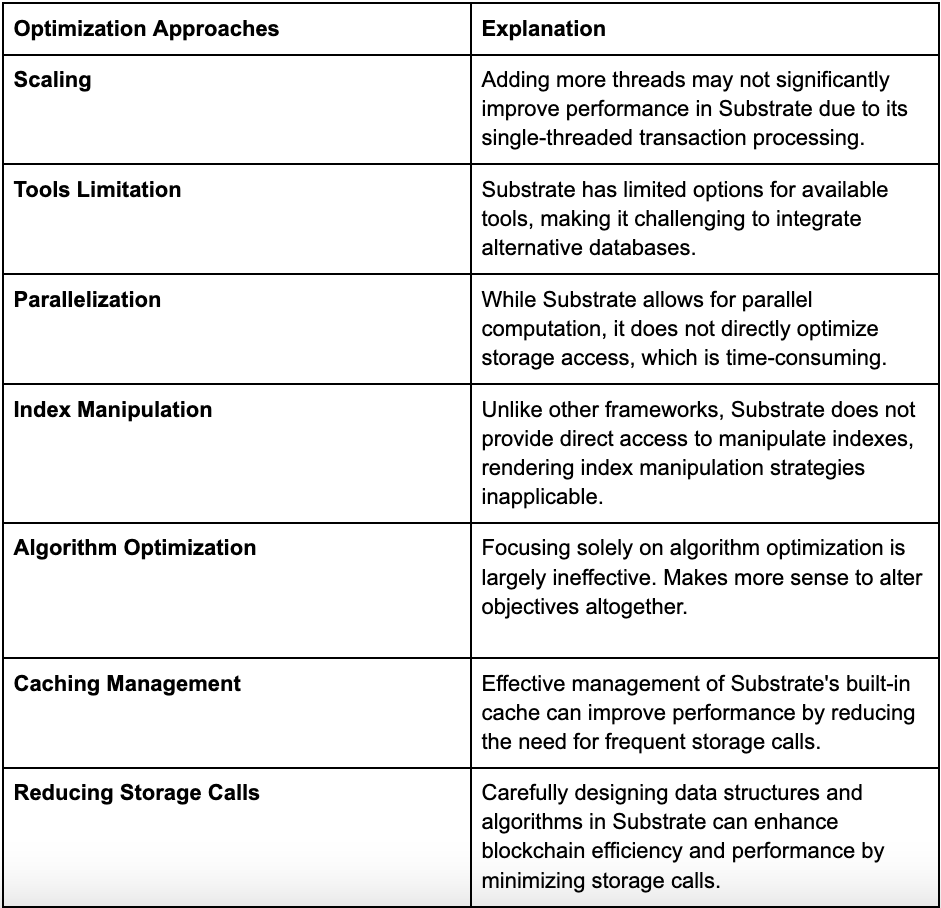Maximizing Performance: Optimization Techniques for Substrate Blockchains

In the decentralized world, optimization is crucial to enhance the efficiency and scalability of various systems. From distributed computing to network protocols, we continually strive to maximize performance and improve user experiences. The blockchain, with its promise of transparent, secure, and decentralized transactions, is no exception. In this article, we'll analyze optimization techniques tailored for Substrate blockchains, shedding light on practical tips to elevate the performance of these innovative platforms.
Before we explore the intricacies of optimization in the blockchain space, let us first establish its significance in the broader context of decentralization.
Why We Optimize Systems
Optimization empowers us to streamline processes, minimize resource consumption, and increase system efficiency. It enables us to overcome challenges in scalability, latency, and transaction throughput. Through efficient algorithms, leveraging parallel processing, and optimizing data structures, we can realize the true potential of decentralized systems.
Transitioning our focus to Substrate blockchains, we unravel unique characteristics and challenges they present to us. As a modular framework for building blockchain solutions, Substrate provides a rich set of tools and functionalities. However, achieving optimal performance on Substrate blockchains requires a deep understanding of the underlying technology and thoughtful consideration of design choices. At the end of the day, a faster blockchain means a better product and more possible design choices.
Armed with this understanding, we embark on a practical journey, presenting a range of optimization techniques tailored for Substrate blockchains. By optimizing storage and implementing caching strategies, we provide actionable insights to improve the performance and responsiveness of Substrate-based networks.
Approaches to Optimization in a Centralized World
There are several approaches to optimization in the centralized world. Let's explore these strategies in more detail:
- Scaling: Scaling involves expanding the system's capacity to handle a larger transaction volume. There are two main scaling techniques:
- Horizontal Scaling: This approach involves adding extra servers to the network, effectively distributing the transaction load among multiple nodes. We can accommodate a growing number of users and transactions with horizontal scaling.
- Vertical Scaling: Vertical scaling focuses on enhancing the capabilities of existing servers by upgrading hardware components such as CPU, memory, or storage, allowing us to improve performance by increasing available computational resources.
2. Choosing the Best Instruments: Selecting a programming language, databases, and message queues like Rabbit MQ affects the efficiency of applications. Opting for technologies well-suited to the project enables us to improve performance and streamline development.
3. Parallelization and Asynchrony: Leveraging parallel processing and asynchronous programming techniques allows tasks to be executed concurrently in a multithreaded environment, enhancing overall efficiency.
4. Database Optimization: Optimizing the database architecture and configuration is essential for efficient data storage and retrieval. We can reduce latency and enhance query processing speed through techniques such as indexing, sharding, and data compression.
5. Code Optimization: Choosing the most effective algorithms and data structures for implementing various functionalities within the application is crucial for streamlined functionality. Optimized code enhances the efficiency and responsiveness of the system, resulting in improved overall performance.
6. Caching Frequently Used Data and Query Results: We avoid redundant computations and minimize the load by storing frequently used data in a cache.
Incorporating these optimization techniques into the development process enhances performance, scalability, and user experience. Leveraging the power of optimization, we meet market demands by delivering reliable systems capable of scaling up with a growing market.
Having understood the streamlining options in centralized systems, let's explore how we can improve blockchain performance for Substrate-based platforms.
Optimizing Substrate Development for Blockchain Performance
When optimizing Substrate development, it's crucial to understand the differentiating factors between Substrate and traditional backend systems. A significant distinction is the access to storage speeds.
In traditional development, memory calls are often made with little consideration for optimization. However, in Substrate, every memory call is expensive. Additionally, Substrate imposes certain limitations on the choice of tools, parallelism, and caching options.
Below is a table explaining the theoretical approaches to optimize blockchain performance within the context of Substrate:

Although certain limitations exist, we can use caching management and reducing storage calls to achieve notable performance improvement within the Substrate framework.
So, from these theoretical examples, what are the practical steps we can take to optimize Substrate blockchains?
Practical Approaches for Optimizing Substrate Blockchains
Before proceeding, let's first comprehend how caching works in the Substrate framework:
- Quick Access: Accessing cached data is much faster than accessing data from storage.
- Cache Population: Data is written to the cache when it's first called from storage.
- Least Used Object Removal: The least used object will be removed if the cache becomes full to accommodate new entries.
Let's now examine practical ways to optimize Substrate blockchains.
- Utilize Constants: Storing parameters in constants is preferable to pallet storage for customized pallets. Constants aren't kept in storage and therefore don't require resources to read from storage. Although modifying a constant requires updating the chain, the performance improvement is significant enough to outweigh this drawback.
- Do not iterate on HashMap: EVM developers who transitioned to Substrate frequently use HashMap to store data. Iterations can be costly, and they don't take advantage of the cache. To address this, we at Equilibrium utilize VecMap - a vector data storage that combines the benefits of a Map interface with high speed.
- Storing Pallet Parameters: We prioritize a minimal number of data structures and encourage the creation of large ones. It has a negligible impact on performance while reducing the amount of memory calls notably improves efficiency. In our experience, reading/writing a vector with 1k elements is comparable to a single element. Minimizing the number of read/write operations is essential for optimal performance.
- Storing Dynamic Data: Let's look at assets as an example. If our chain doesn't allow users to create new assets, and we often need to access parameters such as price, we can store these parameters in a VecMap instead of a HashMap. This way, the asset will be stored in the cache most of the time, resulting in faster transfers.
- Using System Account Data: Before executing an extrinsic, Substrate performs two essential tasks: it checks the nonce and deducts the transaction fee. This action consolidates the System storage into the Account and caches the balances storage. In the cases of Polkadot and Kusama, these two storages are merged, enabling a single read-and-write operation to handle both functions. Expanding the account data provides a suitable place to store frequently used account parameters such as scores, ratings, and nicknames. By leveraging this approach, we can avoid excessive interactions with storage and optimize performance.
- Utilize Off-Chain Workers: Off-chain workers, a powerful Substrate feature, contribute to optimization efforts. They allow delegating heavy tasks to be performed off-chain and only verify the result on-chain. At Equilibrium, we apply this approach to manage margin calls. We utilize off-chain workers to monitor accounts and verify margin calls off-chain. We eliminate the need to check all accounts on-chain, enhancing overall performance.
- Conduct Extensive Stress Testing: To ensure the optimal performance of our blockchain, we understand the importance of thorough stress testing. While benchmarks provide a preliminary understanding of how complex an extrinsic is, they don't consider critical factors like caching and storage size, which are essential for performance optimization. That's why we subject our system to rigorous stress testing.
We develop a deeper understanding of the actual duration of transactions and identify potential areas for improvement through the stress tests. They allow us to fine-tune our system, optimizing it for enhanced performance.
Additional Blockchain Optimization Ideas
In addition to the previous optimization techniques, let's mention a couple ideas to further enhance the performance of Substrate blockchains.
- Custom Caching: One way to optimize performance is by implementing custom caching, which involves preloading data when adding an extrinsic (a transaction) to the pool. We can often determine the necessary data and efficiently preload it into the cache by analyzing the extrinsic’s arguments, ensuring faster access.
- Deparallelizing data access: Currently, the parallelization implementation in Substrate does not allow storage calls and is thus largely ineffective. For Substrate technology to be competitive with, for example, payments giants, deparallelizing data access is mandatory.
These practical optimization techniques for Substrate blockchains allow us to improve system performance. We continue to explore and experiment with optimization techniques to realize the full potential of Substrate-based blockchain systems.
